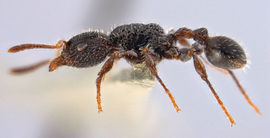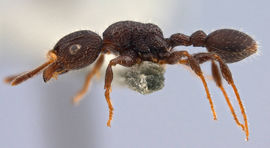Key to Dilobocondyla Species of the Philippines
This worker key is based on: Zettel, H. & Bruckner, H. 2013. Four new species of Dilobocondyla (Hymenoptera: Formicidae) from the Philippines. Zeitschrift der Arbeitsgemeinschaft Österreichischer Entomologen 65:135-150.
Dilobocondyla chapmani sensu lato can be diagnosed by light body colour, pronounced frontal carinae, and a very slender petiole without dorsal transverse ridge. At present it cannot finally be decided whether the available material belongs to one variable species or to several similar species.
Zoogeographical considerations
Based on the structures of the head and petiole (characteristics described in key couplet 1), the six recognised species can be divided in two species groups: (I) The D. chapmani species group includes D. chapmani, D. silviae sp.n., D. rugosa sp.n., and D. carinata sp.n. (II) The D. oswini species group includes D. oswini sp.n. and D. sp. 1. The D. chapmani species group seems to have its closest relatives in Sulawesi (D. selebensis), New Guinea and Australia (D. cataulacoidea Stitz, 1911 and its „variation“ concolor Viehmeyer, 1914; for synonymy see Taylor 1991). The D. oswini species group, although distinct from all congeners by the stout petiole, seems to be more closely related to the species of southeastern Asia including D. borneensis Wheeler, 1916 from Borneo as the geographically nearest species. However, this very preliminary interpretation of faunal relationships may change as soon as more taxonomical and distributional data become available.
It is very likely that all Philippine species of Dilobocondyla are endemic to this country. There is strong evidence for an intra-Philippine regional endemism in both epigaeic ants (e.g., Odontomachus Latreille, 1804, see Sorger & Zettel 2011; Myrmoteras Forel, 1893, see Zettel & Sorger 2011) and arboreal ants (e.g., Pristomyrmex Mayr, 1866, see Zettel 2006; Polyrhachis F. Smith, 1858, see Sorger & Zettel 2009). Such endemism patterns can be explained by pleistocene connections between islands and are congruent in many terrestrial and limnic plants and animals (Ong & al. 2002, Catibog-Sinha & Heaney 2006). Hoever, the present data are to scarce to make conclusions on the regional distribution of Dilobocondyla species.
You may also be interested in
Key to Philippine Dilobocondyla workers
1
- Posterior margin of head strongly concave. Antennal scrobe strongly developed, dorsally limited by prominent frontal carina terminating at posterior corner of head. Petiole either elongated, with PtI 191 - 219, or with a highly raised transverse ridge. (D. chapmani group) . . . . . 2
- Posterior margin of head nearly straight, with faint concavity at its middle. Antennal scrobe moderately developed, dorsally limited by fine frontal carina that is posteriorly fading and not stronger than other rugae of head. Petiole without dorsal transverse ridge and relatively stout, PtI 169 - 180. (D. oswini group) . . . . . 5
2
return to couplet #1
- Petiole with sharp highly raised transverse ridge. Anterodorsal face of postpetiole with regular sharp longitudinal rugae . . . . . Dilobocondyla carinata
- Petiole without transverse ridge. Anterodorsal face of postpetiole differently sculptured . . . . . 3
3
return to couplet #2
- Trunk yellowish to light brown . . . . . Dilobocondyla chapmani (possibly a species complex)
- Trunk entirely or chiefly black or blackish brown . . . . . 4
4
return to couplet #3
- Sculpture very coarse. Meshes on mesosomal dorsum without microsculpture, shiny. Gaster tergite 1 with yellow base . . . . . Dilobocondyla rugosa
- Sculpture much finer. Meshes on mesosomal dorsum with dense microsculpture, matt. Gaster tergite 1 entirely dark . . . . . Dilobocondyla silviae
5
return to couplet #1
- Clypeus with faded microsculpture and 2 - 5 longitudinal rugae. Sculpture of entire mesosoma (including meso- and metapleura) fine, with a dense reticulum of irregular rugae; their meshes with micro-punctures, but still shiny. Petiole and postpetiole relatively elongated; PtI 177 – 181 . . . . . Dilobocondyla oswini
- Clypeus matt, densely microsculptured, with 7 or more longitudinal rugae. Sculpture of mesosoma coarse; dorsum with stronger rugae and wider meshes with dense micro-puncturation, matt; meso- and metapleura with longitudinal rugae. Petiole and postpetiole extremely stocky; PtI ca. 169 . . . . . D. sp. 1 sensu General & Alpert (2012)









